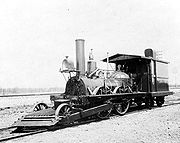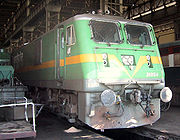
Pilot (locomotive)
Encyclopedia


Locomotive
A locomotive is a railway vehicle that provides the motive power for a train. The word originates from the Latin loco – "from a place", ablative of locus, "place" + Medieval Latin motivus, "causing motion", and is a shortened form of the term locomotive engine, first used in the early 19th...
to deflect obstacles from the track that might otherwise derail
Derailment
A derailment is an accident on a railway or tramway in which a rail vehicle, or part or all of a train, leaves the tracks on which it is travelling, with consequent damage and in many cases injury and/or death....
the train. In some countries it is also called cowcatcher or cattle catcher.
In addition to the pilot, small metal bars called life-guards, rail guards or (UK) guard irons are provided immediately in front of the wheels. They knock away smaller obstacles lying directly on the running surface of the railhead. Historically fenced-off railway systems in Europe relied exclusively on these devices and forwent the use of pilots, but this design is rarely used in modern systems.
Tram
Tram
A tram is a passenger rail vehicle which runs on tracks along public urban streets and also sometimes on separate rights of way. It may also run between cities and/or towns , and/or partially grade separated even in the cities...
s use in place of the pilot a device called a fender. Objects lying on the tram track get hit by a sensor bracket, which triggers the lowering of a basket shaped device to the ground preventing overrunning of the obstacles by dragging it along the road surface in front of the wheels.
In snowy areas the pilot has also the function of a snowplow.
Invention
The pilot was invented by Charles BabbageCharles Babbage
Charles Babbage, FRS was an English mathematician, philosopher, inventor and mechanical engineer who originated the concept of a programmable computer...
in the 19th century, during his period of working for the Liverpool and Manchester Railway
Liverpool and Manchester Railway
The Liverpool and Manchester Railway was the world's first inter-city passenger railway in which all the trains were timetabled and were hauled for most of the distance solely by steam locomotives. The line opened on 15 September 1830 and ran between the cities of Liverpool and Manchester in North...
. However, Babbage's invention was not built, and it is uncertain whether later users were aware of Babbage's idea.
Design
On a mainline locomotive, the pilot has to successfully deflect an obstacle hit at speed; the ideal is to push it upwards and sideways out of the way. The locomotive should not lift on impact or the train will follow, and the ideal is for a fairly smooth structure so that the locomotive will not get caught and derailed.The typical shape is a blunt wedge that is shallowly V-shaped in plan. In the later days of steam locomotive
Steam locomotive
A steam locomotive is a railway locomotive that produces its power through a steam engine. These locomotives are fueled by burning some combustible material, usually coal, wood or oil, to produce steam in a boiler, which drives the steam engine...
s, the front coupler
Coupling (railway)
A coupling is a mechanism for connecting rolling stock in a train. The design of the coupler is standard, and is almost as important as the railway gauge, since flexibility and convenience are maximised if all rolling stock can be coupled together.The equipment that connects the couplings to the...
was designed to swing out of the way also, so it could not get caught up; this was called a drop coupler pilot.
Early on, pilots were normally fabricated of bars mounted on a frame; later on, sheet metal pilots were often used for their additional smoothness, and some cast steel pilots were employed for their mass and smooth shape. Early diesel locomotives followed the same plan.
Early shunting locomotives often had a pilot with steps on it to allow yard workers to ride on the locomotive; these were called footboard pilots. In some countries, footboard pilots are outlawed for safety reasons, and have been removed. Modern locomotives often have front and rear platforms with safety rails where workers can ride.
Modern pilots
Most modern EuropeEurope
Europe is, by convention, one of the world's seven continents. Comprising the westernmost peninsula of Eurasia, Europe is generally 'divided' from Asia to its east by the watershed divides of the Ural and Caucasus Mountains, the Ural River, the Caspian and Black Seas, and the waterways connecting...
an rail vehicles must have pilots with snowplow function and rail guards by law. The required strength of the system is 30 kN (3,059 kp) in the middle of the track and 50 kN (5,099 kp) near the rails.
Modern US diesel locomotive
Diesel locomotive
A diesel locomotive is a type of railroad locomotive in which the prime mover is a diesel engine, a reciprocating engine operating on the Diesel cycle as invented by Dr. Rudolf Diesel...
s have flatter, less wedge shaped pilots; this is because a diesel locomotive has the cab near the front, and the crew are vulnerable to impact from obstacles pushed up by the pilot.
Anti-climbers
To protect the crew and passengers, most modern locomotiveLocomotive
A locomotive is a railway vehicle that provides the motive power for a train. The word originates from the Latin loco – "from a place", ablative of locus, "place" + Medieval Latin motivus, "causing motion", and is a shortened form of the term locomotive engine, first used in the early 19th...
s and passenger cars are fitted with a device known as an anti-climber above the coupler to prevent colliding objects from travelling up over the frame and through the locomotive cab area or through the passenger car. Where a pilot is not fitted, a different type of anti-climber may be used. This is to prevent one passenger car from riding up over another in a collision
Train wreck
A train wreck or train crash is a type of disaster involving one or more trains. Train wrecks often occur as a result of miscommunication, as when a moving train meets another train on the same track; or an accident, such as when a train wheel jumps off a track in a derailment; or when a boiler...
.

